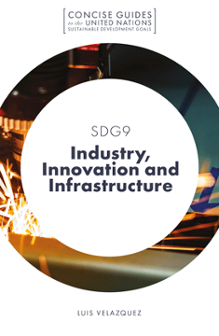SDG9 – Industry, Innovation and Infrastructure

Synopsis
Table of contents
(8 chapters)Abstract
The 2030 United Nations Agenda has framed Sustainable Development Goal 9 around eight targets outlined in Resolution A/RES/71/313 (U.N. General Assembly, 2017). The purpose of this chapter is that the lectors, without much previous knowledge on SDG9, understand the fundamental concepts involved in each of the eight targets. Multiple discussion points emerge when reflecting on the nature of these concepts and others emerge when reflecting on them in the industry settings. The first section of this chapter covers issues concerning resilient infrastructure. Resilient infrastructure is related to targets 9.1, 9.4, and 9.a. This concept needs to cope with extreme natural events potentially associated with global warming and climate change. The second section focusses on the importance of technological innovation in the context of targets 9.5 and 9.b. In a business domain, innovation allows to strengthen industrial competitiveness and increases corporate sustainability. The third concept covered in this chapter is the Information and Communication Technology that is a key to understand target 9.c. Last but not the least, two essential ideas are discussed: Inclusive and sustainable industrialisation and financial services, which are fundamental elements in target 9.2 and target 9.3. In a certain way, it is possible to conclude that both concepts integrate all previous conceptions.
Abstract
To perform a detailed analysis of the inherent complexities in achieving the 9th Sustainable Development Goal (SDG), it is necessary to understand the procedures used by member states delegations to follow-up and review the progress made in implementing the SDGs and targets as mandated in the A/RES/70/1 Resolution adopted by the General Assembly on September 25, 2015 (U.N. General Assembly, 2015); best known worldwide as ‘Transforming our world: the 2030 Agenda for Sustainable Development’. Hence, this chapter aims at providing an overview of sustainability reporting practices to the U.N. High-level Political Forum on Sustainable Development (HLPF). It starts by reflecting on the U.N. landmark events from which the 2030 Agenda emerged and the political and cultural context prevailing at that time. Afterward, it argues on the guidance documents issued by HLPF for following up and reviewing individual countries’ progress. The most controversial issue covered in this chapter undoubtedly concerns information gathering. This issue is because stakeholders consistently question the accuracy of data being provided, not only on Voluntary National Reviews (VNRs) but also on corporate sustainability reports. Therefore, the chapter also covers the guidelines of independent external organisations such as the Global Compact Initiative (GCI) and Global Reporting Initiative (GRI) used by firms to legitimate sustainability reporting content and increase reliability. Finally, this chapter concludes with a brief description of required procedures to submit and present VNRs.
Abstract
The U.N.’s perseverance in fostering sustainable industrialisation has not rendered the expected results in the long run. Despite that the scope of SDG9 is reasonably well defined and communicated, there is much more to be done to make it a reality. Achievements on SDG9 have not been as positive as they might have. It should be noted that there is no trustworthy source of information that indicates with certainty the progress towards the 2030 agenda. The purpose of this chapter is to examine factors involved in the SDG9 reporting and other critical issues necessary to understand the progress and how we are progressing towards SDG9. From this point on, data for our debate come from several sources. Still, the primary outcomes come from the 2017 High-level Political Forum on Sustainable Development, the Sustainable Development Goals Report 2020, the 2020 Voluntary National Reviews (VNRs) independent assessment, and other Sustainable Development Goals (SDGS) reports as well as scientific literature. Unfortunately, there appears to be a lack of reliable SDG9 information available, and what exists is hard to find. In general, information sources often offer qualitative information, and quantitative data are scarce. This situation is especially the case for the documents presented in the chapter, which provided a few statistics disaggregate data, making it challenging to analyse in-depth. The debate here presented does not seek to be a fully comprehensive assessment of their content. The analysis is not designed to interpret or replace the referenced documents, either. Instead, it is intended to illustrate the difficult task of measuring the progress towards SDG9.
Abstract
In resolution A/RES/74/4, the U.N. Nations General Assembly adopted the Decade of Action to accelerate the achievement of the SDGs by 2030. The Decade of Action calls to improve actual efforts to accomplish the 2030 agenda for governments, civil society, the private sector, and other stakeholders. This call is the last opportunity we have to reach SDG9. Still, unfortunately, the COVID-19 pandemic has severely affected all industrial sectors, which is unlikely to achieve inclusive and sustainable industrialisation by 2030. This chapter illustrates the adverse effects that the construction, manufacturing, and hospitality industries have suffered since the beginning of the COVID-19 pandemic and how they gradually have returned to the new normal. It also shows the case of the industry that could be considered the ‘champion in the covid era’, the high-tech industry. Predominantly in covid times, high-tech firms have been a synonym for technological innovation, which is an absolute necessity to encourage competitiveness in all industrial sectors, mainly in essential activities. Finally, the chapter is closed with an invitation to reflect on the fundamental principle of SDG9, which is sustainable industrialisation, but above all, inclusivity. SDG9 cannot be considered achieved until its benefits are transferred to the countries in the global south.

- DOI
- 10.1108/9781801171311
- Publication date
- 2021-11-26
- Book series
- Concise Guides to the United Nations Sustainable Development Goals
-
- Series copyright holder
- Emerald Publishing Limited
- ISBN
- 978-1-80117-134-2
- eISBN
- 978-1-80117-131-1